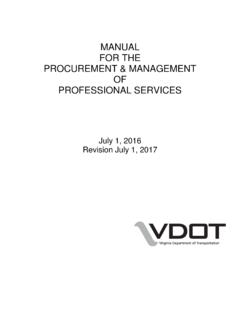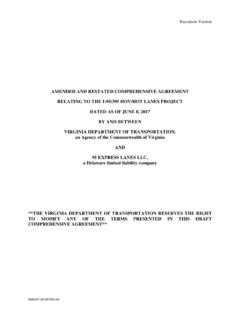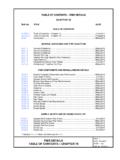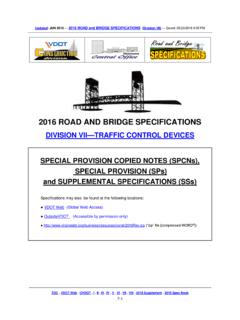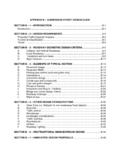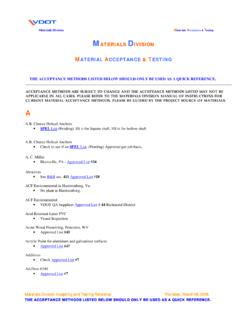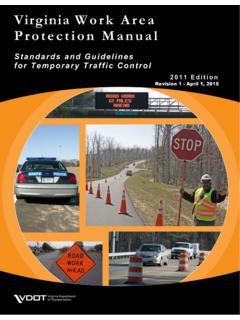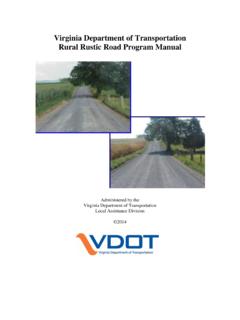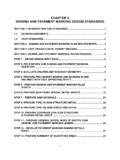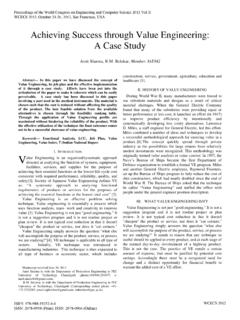Transcription of MOI Chapter VI 8-9-2018
1 August 2018 VI-1 SECTION 601 FUNDAMENTAL CONCEPTS OF PAVEMENT DESIGN AND 3 Sec. Introduction .. 3 Sec. Project Pavement Evaluations .. 4 Sec. Patching Survey Guidelines .. 17 SECTION 602 FALLING WEIGHT DEFLECTOMETER TESTING AND ANALYSIS GUIDELINES .. 22 Sec. Introduction .. 22 Sec. FWD Testing .. 22 Sec. FWD Data Processing .. 22 SECTION 603 GUIDELINES FOR USE OF THE MECHANISTIC-EMPIRICAL PAVEMENT DESIGN .. 25 Sec. Purpose .. 25 Sec. Pavement Design .. 25 SECTION 604 GUIDELINES FOR USE OF THE 1993 AASHTO PAVEMENT DESIGN PROCEDURE .. 28 Sec. Purpose .. 28 Sec. Flexible Pavement Design.
2 28 Sec. Rigid Pavement Design .. 34 SECTION 605 ASPHALT CONCRETE MIX SELECTION GUIDELINES .. 42 Sec. Purpose Of Guidelines .. 42 Sec. Description Of Asphalt Concrete Mixes .. 42 Sec. VDOT Asphalt Binders .. 47 Sec. Asphalt Mix selection General Applications .. 48 Sec. Asphalt Binder and Mix selection Specialized locations .. 51 Sec. Application Rates .. 52 Sec. Typical asphalt Base mix application rates .. 53 SECTION 606 PAVEMENT TYPE SELECTION PROCEDURES DETAILS .. 55 Sec. Introduction .. 55 Sec. Pavement Type Selection .. 55 Sec. Pavement Types .. 55 Sec. Pavement Design.
3 56 Sec. Pavement Type Selection Procedures (PTSP) .. 56 August 2018 VI-2 Sec. Alternate Bidding .. 59 Sec. How To Use The Procedures .. 59 SECTION 607 LIFE CYCLE COST ANALYSIS .. 62 Sec. Executive Summary .. 62 Sec. Introduction .. 62 Sec. Economic Analysis Components .. 64 Sec. Cost Factors .. 66 Sec. Overview Of LCCA Pavement Options .. 68 Sec. Asphalt Pavement Construction/Reconstruction .. 69 Sec. Jointed Concrete Pavement Construction/Reconstruction With Tied Portland Cement Concrete Shoulders .. 73 Sec. Jointed Plain Concrete Pavement Construction/Reconstruction With Wide Lane (14 Feet) And Asphalt Concrete Shoulders.
4 76 Sec. Continuously Reinforced Concrete Pavement Construction/Reconstruction With Tied Portland Cement Concrete Shoulders .. 78 Sec. Continuously Reinforced Concrete Pavement Construction/Reconstruction With Wide Lanes (14 Feet) And AC Shoulders .. 80 Sec. LCCA For Major Rehabilitation Projects .. 82 Sec. Unit Costs And Measures .. 82 Sec. Interpretation Of Results .. 83 SECTION 608 PROJECT SELECTION GUIDELINES FOR COLD PAVEMENT RECYCLING .. 85 Sec. Purposes and Goal .. 85 Sec. Definitions .. 85 Sec. Selection of Rehabilitation/Construction Projects .. 86 Sec. Exceptions .. 89 August 2018 VI-3 Chapter VI PAVEMENT EVALUATION AND DESIGN SECTION 601 FUNDAMENTAL CONCEPTS OF PAVEMENT DESIGN AND EVALUATION SEC.
5 INTRODUCTION One of the State of Virginia s largest assets, if not the largest asset, is the highway network system. The Virginia Department of Transportation (VDOT) is responsible for maintaining the third largest roadway network in the United States encompassing over 53,000 miles. VDOT s Materials Division s Pavement Design and Evaluation (PD&E) Section is responsible for the review and comment on new and rehabilitated pavement structures around the state. PD&E assists the districts in the overall management of Virginia s highway construction program by providing guidance, technical assistance and training.
6 An important function in pavement management is project level analysis of existing roadway sections. Project level analysis is the inspection of existing pavements to determine the causes of deterioration and to assess the current condition. Once project level analysis has been conducted, then the most reliable pavement design can be performed. For new construction and rehabilitation projects, the combining of existing condition data, future traffic projections, soil subgrade properties and paving material properties will ensure a proper pavement design. This analysis and design should apply not only to pavement reconstruction and rehabilitation projects, but to routine and preventative maintenance projects as well.
7 The purpose of this document is to provide guidelines for VDOT s Pavement designers in conducting project evaluations and pavement designs on Major (Interstate, Primary, Urban and High-Volume Secondary) Roadways and Minor (Low-Volume Secondary and Sub-Division) Roadways. The amount of pavement evaluation required will be dependent on the scope of the project; the pavement design process will depend on the roadway classification (Interstate, Primary or Secondary). This document covers design considerations for routine maintenance, rehabilitation and construction activities performed by VDOT. However, it does not preclude from consideration of new and innovative pavement techniques.
8 NOTE: The requirements for pavement design, as established herein, shall be followed unless waived by the District Materials Engineer or District Materials Engineer designee. August 2018 VI-4 SEC. PROJECT PAVEMENT EVALUATIONS Major Roadway project evaluation process is a two-step procedure: Step 1 Preliminary Pavement Analysis and Design, Step 2 Detailed Pavement Evaluation and Design. Major Roadways consist of Interstate, Major and Minor Arterial, and Major and Minor Collector routes. Step 1 occurs during the project-scoping phase. Step 2 occurs after the scoping phase during the Planning, Specifications and Estimating (detailed design) development.
9 The details for these evaluations are provided in the following sections. (a) Preliminary Pavement Evaluation Step 1 is the preliminary pavement analysis and design. This process will occur once the District Materials Engineer has been notified that a project requires a pavement design. Ideally, the Location and Design Section will notify the District Materials Engineer prior to establishing a preliminary construction estimate. With pavement items being a large percentage of the overall construction cost, a good initial estimate will aid L&D in requesting construction funds. At the preliminary evaluation and design phase of a project, the PD&E Section may provide technical assistance to the Pavement designer upon request.
10 To conduct the preliminary pavement evaluation, the Pavement designer will conduct 4 tasks. These tasks are: Task 1. Data Gathering Task 2. Field Data Collection Task 3. Preliminary Recommendation Task 4. Determine Need for Detailed Pavement Evaluation Figure 1 shows the process flow for the preliminary pavement evaluations. August 2018 VI-5 Figure 1 - Preliminary Pavement Evaluation Process Flow Task 1. Data Gathering: Traffic Data Pavement Layer Data Soil Data Visual Condition (if relevant) Ride Quality (if relevant) Friction Data (if relevant) Maintenance Data (if relevant) Structural Capacity Task 2.
